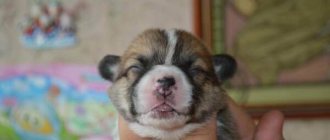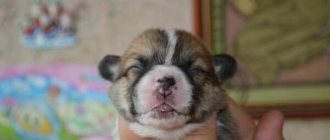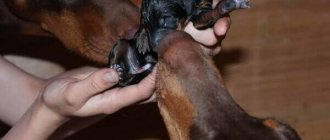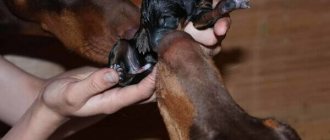The Welsh Corgi is a good-natured, sociable small dog.
The Welsh Corgi's muzzle is similar to a fox, height at the withers is 25 - 30 cm, weight is 10-15 kg.
Life expectancy is 12-15 years.
The second name for the Welsh Corgi is a short-legged shepherd dog, a strong, compact and quite strong dog - a boundless optimist and a wonderful companion.
What do newborn puppies look like in the photo and when do they open their eyes?
Newborn Welsh Corgi puppies are almost completely helpless; the only thing they can do is crawl in a circle and suck.
Babies are born blind, deaf, and dependent on an external source of heat.
Among other things, newborns are not able to defecate on their own; their mother helps them by licking their belly. Puppies' eyes open 10-15 days after birth.
welsh-corgi.by
Congratulations! A charming Welsh Corgi puppy has appeared in your home. How to care for a corgi puppy? are there any special features? Usually new owners have a lot of questions, and I will try to answer some of them in the article.
- Who can I ask how to properly feed, walk, and brush a Corgi puppy? Many new owners are embarrassed to call the breeder with these questions and use recommendations from neighbors and relatives. DON'T DO THIS unless your neighbor has been breeding corgis for the last 10 years. Contact the breeder. You won’t believe it, but selling a puppy is not “money in the evening, chairs in the morning.” This puppy is as dear to your breeder as it is to you. He raised him, knows a lot about him, can tell him a lot. A good breeder will not refuse to help you.
- After the move, the puppy is sad. Moving to a new home, being separated from your mother and siblings is stressful. To reduce it, ask the breeder to give you something from the “native smell” with a familiar smell: a toy, a diaper. Do not change your routine or introduce anything new (walks, food) for 1-3 days from the moment of moving. Let him get used to you and his new home. There may be whims and even “tears”, but, as a rule, this passes quickly and the corgi adapts to the new life. Try to be as patient and understanding as possible! Caress, hug, reassure your new family member. He needs a strong shoulder and a vest now.
- How to pick up a puppy? Only under the chest! Don't pull the puppy's paws or try to lift him up like that. At 2-3 months old, a Corgi is already quite heavy, and lifting it incorrectly can provoke aggression: the puppy is in pain and may bite you. Place your palm under the puppy's chest, place your middle fingers between the paws, and place your thumb and little finger on each side. Now you can lift it. If there are children in your house, explain it correctly or even explain that there is no need to pick up the puppy.
- DO NOT allow your Corgi puppy to jump off couches or from your hands. It's bad for him! His bones and ligaments are not yet strong enough to withstand such jumps without causing damage.
- A puppy is a curious creature with teeth . Don't underestimate the intelligence and curiosity of the Corgi. If a little cookie wants to get something, he will try to get it. To prevent “this” from harming the puppy itself, remove household chemicals and wires at a higher level, make the trash can and shelves with shoes inaccessible to the toothy researcher. Children's toys forgotten by a child on the floor can be mercilessly torn to pieces (good if they are made of soft plastic. Worse if they are made of brittle and brittle!). If you do not have the opportunity to lock your puppy in a separate room when leaving home, away from tempting shoes, toys, books and inlaid furniture, purchase a cage or pen and lock the puppy there while you are away.
- Corgi puppy needs toys. Your puppy will have a long period of teeth growth. First, these are baby teeth, then the replacement of teeth with molars and their growth. All this time, the puppy’s teeth itch and itch. He needs to chew on something. Buy him special toys: ropes, toys made of thick rubber. Homemade toys made from old rags work well (just tie knots from a rag, old socks, etc.). Many puppies consider raw carrots, cabbage stalks, cucumbers, potatoes, and apples to be the best toys. You can use store-bought treats: beef ears, trachea, etc. Old shoes are not suitable for play: the puppy will think that other, newer shoes and slippers can be chewed.
Funkyfox Ambition Boy
- Place: cage, bed, pen. Many people think that keeping a dog in a crate is cruel. Actually this is not true. Yes, keeping a dog in a cage around the clock, without walks, without even allowing it to stretch its legs, is cruel. But a spacious cage where your pet can go on vacation is convenient for both you and him. Corgis have an impressive undercoat, so choose a place away from heating appliances. It should not be on the walkway or at the front door (a vigilant dog may react violently to sounds from the entrance). The puppy should feel completely safe in its place. This is his shelter and fortress. Here you cannot punish, give injections, or give medications. From the first days, take the puppy to the crate when he starts to fall asleep. Soon the puppy will remember this and will go there himself. Crate training your puppy will greatly reduce damage to your belongings as teeth grow and change. You need to choose a bed or bedding for your corgi that is cool and easy to clean.
- about feeding
in some detail here - Vaccinations. By the time the puppy moves into your home, most likely, it has already had one vaccination and you only need to repeat the multi-vaccination. The most common vaccine is the Dutch Nobivac. She is vaccinated several times: at the age of 8-9 weeks and again at 12 weeks. 10 days before vaccination, give the puppy anthelmintic. This could be the common Drontal + or Prazicide, or any other anthelmintic suitable for dogs and puppies. Read the leaflet and give the drug according to the puppy’s weight. Anthelmintic must be given MANDATORY! Parasites greatly weaken the immune system, and if a weakened puppy is given a vaccine (essentially also undead microbes), the body may not cope. The consequences are very sad. If after anthelmintic you see worms in your stool, postpone the vaccination and drive away the parasites again after 10 days. Only a veterinarian can administer the vaccination. If your puppy has diarrhea, is lethargic, and doesn’t eat well, put off vaccination! The veterinarian is obliged to vaccinate the dog, having previously examined it, note the date of vaccination and the drug in the veterinary book, and put a stamp. Vaccination against rabies and leptospirosis is given no earlier than 12 weeks. Some people vaccinate it after the puppy’s teeth have been replaced with molars. But in case you need to take the puppy abroad, you need to vaccinate the puppy at 12-13 weeks and wait 21 days for quarantine. Only after this can you take your dog abroad. During the period of vaccination and quarantine, do not bathe or overcool the puppy! Monitor your baby's condition: on the first day after vaccination, he may be lethargic and eat poorly. This is fine. It is not normal if the puppy gets worse 3-5 days after vaccination. After the first vaccinations, revaccination should be carried out once a year.
- Walks. A puppy is like a child. He is interested in everything, he puts everything into his mouth. This is exactly what is dangerous. I recommend not walking your puppy until 2 vaccinations have been given and at least 10 days have passed after them. Immediately (1-3 days) after vaccination you CANNOT walk outside with the puppy! The immunity of breast milk has already passed, but its own (vaccine) immunity has not yet been developed. This is the most dangerous time when a small puppy is most vulnerable to all kinds of diseases. Especially in the city. Especially when in contact with other dogs. Hold off on walks. Health is more valuable. Please note: a walk is about communication between you and the puppy, playing together, doing activities, and not about the puppy interacting with other dogs. Until your Corgi knows basic commands and is trained to listen to you, limit his interactions with his own kind. This is the time to establish human-dog contact. Do not allow your puppy to pick up anything from the ground (bones, feces, carrion, bags of food)! It is very dangerous.
Types of Welsh Corgi puppies
Welsh Corgi puppies, like adult dogs, are divided into 2 groups within the breed: Pembroke and Cardigan.
The latter are slightly larger in size and calmer, they are often less sociable than the Pembroke.
Another distinctive feature is the shape of the ears and tail. Cardigans have more rounded ears than Pembrokes, and their tail is longer and more fox-like.
As for Pombrokes, they are more active, cheerful, sociable and slightly smaller in size..
Where to buy and how much it costs
To purchase a purebred Welsh Corgi puppy, you should contact a reliable kennel or a reputable breeder. Advertisements on the Internet and at poultry markets often sell non-purebred or sick animals.
The Welsh Corgi dog breed is difficult to breed, so puppies are quite expensive. Kids are divided into several classes:
- Pet class - not suitable for exhibitions and breeding, as it has disqualifying defects. These dogs are kept as pets. Cost 20-25 thousand rubles.
- Breeding class - animals with good pedigrees, but some shortcomings that will not allow them to succeed at shows. Widely used in breeding. A Corgi puppy in Russia costs 30-40 thousand rubles.
- Show class are the best individuals with great exhibition prospects: they have almost ideal anatomy and temperament. Cost – from 60 thousand rubles and above.
Famous kennels of the Pembroke and Cardigan Welsh Corgi:
- “Crimson Autumn” https://corgi-pembroke.com (Moscow);
- Aethwyhttps://welshcorgi.ru (Moscow region, Pushkinsky district);
- “FanCorgi” https://fancorgi.ru (Kaluga region);
- “Atsel Hof” https://vk.com/atselhof (Tambov);
- "Arabelde Grand" https://vk.com/pembrokeufa (Ufa).
Welsh Corgis are cute dogs with a unique character and unusual appearance. Having spent time and effort choosing and caring for a puppy, a person will receive a devoted and cheerful friend with whom he will never be bored.
How does it develop day by day in the first month?
| Days | Development |
| 1-5 | The baby is completely helpless; during this period he does not know how to empty himself and needs additional heating, and also cannot hear or see. |
| 6-8 | The puppy experiences intense weight gain and the first reflexes begin to appear. |
| 8-9 | By this time, the weight of the newborn doubles. |
| 10-15 | The baby's eyes begin to open. In this case, the pupils react to light, but at the same time the puppy is still poorly oriented, since the retina of the eye is still in the process of development. |
| 16-18 | By this age, the Welsh Corgi puppy begins to activate its own thermoregulation. The baby gradually learns to cope without additional heating. |
| 19-21 | The puppy reacts to the sound and gradually begins to hear. |
| 22 | The first teeth erupt and the baby begins to try solid food. |
| 23-24 | The puppy already knows how to bite and chew. At the same time, his sucking reflex gradually fades away. During this period, the baby Welsh Corgi actively explores the world. |
| 25-30 | The baby begins a period of primary socialization, he already responds to a nickname, can leave the nest for a short time, actively moves and plays. |
Optimal nutrition
At the stage of choosing a future pet, a person must clearly understand that he will have to feed it with high quality. Feed! And this concept does not hide feeding cutlets, sausages, sausages or other delights from the master’s table. The dog must receive proper, balanced nutrition.
A well-designed menu is a guarantee of the dog’s health and well-being, and also that you will not be a regular visitor to veterinary clinics.
Whether or not to prepare natural food for your pet daily is the owner’s decision. Not everyone has enough time to cook. Most people prefer ready-made commercial feed.
The owner’s main task is to choose high-quality food: premium or super-premium.
You can determine if food is suitable or not based on the following criteria:
- The pet looks great;
- Excellent wool;
- There are no stool abnormalities;
- Doesn't bother your ears;
- There are no skin diseases;
- No discharge from the eyes;
- Normal weight.
If the indicators coincide with reality, then you are incredibly lucky. They don’t look for good from good - don’t change the brand unless absolutely necessary.
When using dry food, it is necessary that the dog always has access to drinking water. Under the influence of liquid, the granules swell in the stomach, increasing in size. Actually, for the same reason, you should not leave a bag of pet food within reach.
How does it develop from 1 to 12 months?
Development of the Welsh Corgi from 1 to 12 months:
| Age (months) | Description | Size(cm) | Weight |
| 1 | The newborn period, in the first two weeks the puppy is absolutely helpless, blind and deaf. Starting from the third week, the baby’s eyes open, and a little later he begins to hear. By the end of the first month, the puppy switches to solid food and is actively interested in its surroundings. | 8-12 (newborn). 14-16 cm (by the end of the first month) | 300-600 g (newborn weight). 1.1-1.8 kg (puppy weight by the end of the first month). |
| 2 | The puppy's first baby teeth appear, he plays with toys, and is actively learning communication skills. | 16-20 | 2.1-2.9 kg |
| 3 | The baby Welsh Corgi goes through a period of socialization and continues to grow. The puppy continues to study the laws of the pack, dominant and weaker individuals begin to clearly appear. | 20-22 | 2.8-4.1 kg |
| 4 | By this age, the baby’s teeth change and their own immune system begins to form. | 22-24 | 4.1-5.4 kg |
| 5 — 6 | The puppy enters adolescence, restructuring occurs in his body, and hormonal levels change. It is during this period that teenage dogs begin their first sexual games. The dog's behavior during this period may change not for the better. | 20-28 | 5.6-8.5 kg |
| 7-9 | During this age period, Welsh Corgi bitches begin their first heats, they are active, excitable and already quite capable of fertilization. Males enter this stage a little later. | 28-30 | 7.2-8.5kg |
| 10 -12 | Completion of puberty. By this age, the dog has already reached puberty. Growth stops, the animal begins to gain strength. | 28-30 | 9-15 kg |
Obesity in pets
Excess weight not only spoils the appearance, but also significantly worsens the health of your four-legged friend. Causes of obesity include metabolic diseases, genetic predisposition, a sedentary lifestyle and poor diet. Residential dogs are often affected.
Spayed female dogs often become predisposed to gaining excess weight. Disturbed hormonal levels provoke obesity
Up to a certain point, owners may be amused by the rounded shape of the Welsh Corgi, but excess weight is a colossal burden on the dog’s body. If you do not start the fight against extra pounds in a timely manner, obesity will set in - a real problem that leaves a negative imprint on the dog’s life and well-being.
Obesity contributes to the development of dangerous diseases that are often irreversible: diabetes mellitus, pathologies of the cardiovascular system. Don't forget about problems with the spine and joints that occur in overweight dogs. Therefore, you can’t risk your pet’s health; you need to start fighting excess kilograms in a timely manner!
How do you know if your body weight is normal? The most important criterion is the breed standard - the numbers are clearly written there. In addition to official indicators, you need to focus on your own animal, because... Every dog's body is different. Feel your pet's ribs - at a normal weight, they are easy to feel.
Also, in a non-obese dog, the ribs will protrude above the level of the abdomen when lying down. If you are overweight, it is difficult to see the respiratory movements of the chest.
Associated symptoms are shortness of breath, fatigue, and decreased performance.
The most important question: what to do? Bring your pet to the veterinarian. The specialist will conduct a thorough examination, prescribe, if necessary, examinations or tests, a special diet and advise the correct physical activity.
A suitable diet program is a key point in the fight against the worst enemy of a slim figure. The selected diet for an overweight dog is used to improve metabolism, lose weight, and strengthen the immune system. It is important to follow the veterinarian’s recommendations, follow a diet and prohibit family members from feeding the animal “delicacies”!
Physical activity is selected according to the individual characteristics of the corgi. Based on the condition and weight of the animal, the doctor prescribes an appropriate training program. It is important to increase the load gradually, listening to your own dog.
What should care be like?
To keep your pet healthy and live a long and happy life, follow these rules::
- Choose the right diet for your pet and feed it in accordance with age and weight standards. As for food, it must be of high quality, balanced and suitable for the Welsh Corgi breed.
- Take your baby for walks regularly, because Welsh Corgis need physical exercise. This is necessary for the proper development of joints and the entire musculoskeletal system.
- Inspect and clean your pet's eyes daily.
- The dog's nails need to be trimmed approximately once every 2-3 weeks.
- Bathe your dog at least once every 2-3 months. When bathing, use only social shampoos and conditioners designed for dogs.
- Be sure to give your pet vitamins and nutritional supplements containing beneficial substances.
- Give your dog anthelmintic medications once every 3 months.
- Once a week, the pet’s teeth are brushed with a special brush and toothpaste intended for dogs.
- Accustom your dog to a leash and collar from an early age, this will avoid many problems in the future.
- Try to find a good veterinarian.
- Take your dog to the veterinarian at least once a year.
- Give your pet a hygienic haircut once every six months.
Character and temperament
Welsh Corgis are active and sociable dogs. They lack anger and nervousness. Pembrokes are eternal children at heart, Cardigans are calmer and more reasonable.
Corgi puppies stand confidently on their short legs and always run out to meet a new person. If the baby is too timid or aggressive, it is better to refuse the purchase.
Mandatory questions for the breeder
To choose the right Corgi puppy and ensure the professionalism of the breeder, you should ask the following questions:
- Are the baby and his parents healthy, how long have they been treated for worms, fleas and ticks, have they been vaccinated - a conscientious seller will easily give answers.
- Is it possible to examine the parents - if the breeder hides the sires, it is better to refuse the purchase.
- How many years has a person worked with Welsh Corgis, what are his goals? It’s good if one breed is bred in a kennel, and puppies appear only as a result of planned matings 2-3 times a year.
- What did they feed the baby? - after moving to a new home, the puppy is fed only foods that are familiar to him.
- What is the situation with the documents - the nursery must be registered with the RKF/IKF. The fact of purchasing a puppy is confirmed by a purchase and sale agreement.
There is no need to be shy - a responsible breeder will answer all questions. He is not indifferent to the fate of the puppies, so sincere interest will only strengthen the confidence that he is leaving the baby in good hands.
What to feed for the first 3 months?
A Welsh Corgi puppy can be fed both natural food and kibble. The main condition is not to mix them.
Products that must be included in the diet:
- Lean meat.
- Good quality porridge (buckwheat, oatmeal, rice).
- Eggs.
- Dairy products.
- Offal.
- Boiled fish.
- Vegetables (fresh or boiled).
You can give cheese or dog biscuits as a treat..
Brief description of the breed
Corgi is a herding and herding breed of dog. It originated about 300 years ago. Not very common in Russia. But it is popular among elite families as an exotic breed of animal. Externally, dogs resemble a fox.
Description of corgi appearance:
- The body is elongated.
- The height is low - about 25-30 cm at the withers.
- The ears are large and erect.
- Paws are straight.
- The eyes are round, dark in color, with a black rim.
- Tails are docked.
- The coat is soft and thick, and can become wavy.
- There is undercoat.
- The color can be sable, red, black and tan, fawn.
- A characteristic feature of the breed is the presence of white markings.
- There is a saddle-shaped mark on the back.
- An adult animal weighs from 12 to 16 kg .
The average lifespan of a Corgi is 12-15 years . The dogs are docile and friendly in nature. They quickly become attached to their owner. Corgis have nanny skills: they protect and entertain small children. Such animals make good and loyal friends.
How to feed correctly and how often?
Proper nutrition means not only the quality of food, but also the regularity of feeding and the volume of portions.
Feeding frequency:
- A 2-month-old puppy should be fed 6 times a day in divided portions.
- At 3-5 months, the baby needs 5 meals a day.
- At 6 months of age, the dog can be switched to 3 meals a day.
- At 10 months of age, the puppy can eat 2 times a day.
70% of a Welsh Corgi's diet should consist of foods containing protein.
Menu for the week
Monday:
- Breakfast - cottage cheese, kefir or yogurt.
- Lunch - buckwheat porridge with boiled lung.
- Dinner – a piece of fish.
Tuesday:
- Breakfast - kefir or cottage cheese.
- Lunch – rice porridge with boiled turkey.
- Dinner - boiled beef with cabbage.
Wednesday:
- Breakfast – low-fat broth.
- Lunch – buckwheat porridge with liver.
- Dinner – oatmeal with fish.
Thursday:
- Breakfast: cottage cheese or kefir.
- Lunch – low-fat broth with a piece of meat.
- Dinner – rice porridge with liver.
Friday:
- Breakfast - low-fat chicken broth.
- Lunch - buckwheat with boiled heart.
- Dinner – kefir or cottage cheese.
Saturday:
- Breakfast – low-fat boiled fish.
- Lunch – buckwheat porridge and a piece of chicken.
- Dinner – oatmeal with stewed cabbage.
Sunday:
- Breakfast - yogurt, cottage cheese or kefir.
- Lunch – rice porridge with heart.
- Dinner – stewed beets with fish.
From an early age, accustom your pet to a limited amount of food, give exactly as much as necessary.
Vaccination schedule. Which ones are needed?
The first vaccinations for Welsh Corgi puppies can be given no earlier than 8-10 weeks of age.
Vaccination schedule:
- At 8-10 weeks, a comprehensive vaccination against leptospirosis, paragippus, distemper, parvovirus enteritis, hepatitis, adenovirus infection, and rabies is given.
- At 12-15 weeks, revaccination against the same ailments is given.
- At the age of 6-7 months, the procedure is repeated.
- At 12 months of age they do the same.
- Every year the dog is vaccinated against diseases such as distemper, rabies, parvovirus enteritis, hepatitis, leptospirosis, adenovirus infection. In this case, it is very advisable to use a vaccine from the same manufacturer.
Choosing a pet
The choice of a puppy should be approached with all responsibility, so as not to be disappointed in the dog later and not to spend huge sums on its treatment.
At what age can you adopt a puppy?
Welsh Corgi puppies are separated from their mother no earlier than 6-8 weeks. Show dogs are adopted later - at 6-7 months, when their anatomical and behavioral characteristics become visible.
Which gender to choose
Both boys and girls Welsh Corgis make excellent companions - loyal, kind and cheerful. However, dogs have characteristics that depend on gender:
- Boys are more straightforward and assertive. They are often bred for exhibitions and sports. Males do not go into heat and have no forced breaks for pregnancy and caring for puppies. While on a walk, a dog may run away when it smells a dog in heat.
- Girls are more cunning, but more flexible. Before heat, they can become irritable and disobedient. When the female is “in heat”, she will have to be protected from contact with males in order to avoid accidental mating.
Important. Welsh Corgis have a difficult time giving birth, often requiring a caesarean section. Therefore, breeding them is very difficult.
Every dog has individual traits. To choose a boy or girl corgi, it is better to first decide for what purpose the pet is needed.
What to pay attention to
When choosing a puppy, the following deserve close attention:
- appearance – babies should look well-fed and well-groomed;
- conditions – in good kennels, dogs are kept in clean and spacious premises;
- availability of documents - puppy birth certificate, veterinary passport.
Appearance and physical condition
In healthy Corgi puppies:
- clear view;
- skin without wounds or ulcers;
- shiny wool;
- clean ears and eyes without redness or discharge;
- White teeth;
- moderately well-fed physique.
In boys, both testes should be descended into the scrotum.
For your information. Pembroke Welsh Corgi puppies come in bob-tailed and long-tailed varieties. If the tail is docked, the dog will not be able to participate in international shows in countries where tail docking is prohibited.
Corgi puppies look very touching, they are mobile and agile. Lameness and restricted movements are reasons to refuse the purchase.
Allowed colors:
- corgi-pembroke – puppies can be red, sable, fawn with or without white markings, tricolor (black and tan with white spots);
- cardigan - includes the same colors plus blue merle and brindle.
Dogs of other colors are considered breeding grounds.
How to train correctly and what should training be like?
Usually training begins with setting the correct intonation. A commanding and playful tone is the best option for a Welsh Corgi. After all, the puppy perceives training as a game.
The first stage is to accustom the baby to his nickname . Then you can start learning the command - “come to me”. To do this, say the nickname loudly and then the command. If your pet understands what is required of him, give him a treat.
The next command is “place”, pronounced in a stern voice and repeated as many times as necessary.
Another important command, “fu,” is given whenever the dog takes prohibited actions. After the command “fu” the treat is not given.
NOTE!
After the puppy has learned the basic commands, you can move on to active training.
The “fetch” command is perfectly accepted by the puppy and he carries it out with pleasure. It is usually practiced on the playground.
Whenever your dog has followed a command correctly, give it a treat. This way you can reinforce the skill.
Education and training
Welsh Corgi puppies begin to be trained in early childhood. At the initial stages, the dog is taught its own name, after which it is introduced to the most necessary commands:
- "To me!";
- "Place!";
- "It is forbidden!";
- "Ugh!".
Orders are given in a firm but gentle voice. If the Welsh Corgi has performed the required action, it is petted and treated with a treat.
From 3-4 months, the puppy is trained more actively and persistently. It is advisable that the pet knows the commands:
- "Sit!";
- "Lie!";
- "Stand!";
- "Walk!";
- “Aport!”;
- "Give!".
In the future, the puppy can be taught various tricks.
Important. The Welsh Corgi needs systematic physical and mental exercise - you need to exercise it every day.
How to stop barking for no reason
The Welsh Corgi has a clear and loud voice. This breed of dog rarely barks without a reason, but the pet may often disturb the silence if:
- bored;
- something is bothering him;
- wants to attract attention;
- begs for what he needs.
If the puppy is healthy, the best way to stop him from barking is to distract him with play. For example, throw a ball or show your favorite toy. The Welsh Corgi's attention will switch to another object, he will throw out the accumulated energy and calm down.
It is advisable to teach the puppy the “Silence!” command. When he starts barking, you should carefully cover his mouth with your hand, repeating the order several times. Soon the Welsh Corgi will get used to falling silent on its own without outside help.
Important. You cannot shout, hit the puppy or indulge his whims. This will only make the situation worse.
How to distinguish a boy from a girl?
To determine the sex of a newborn Welsh Corgi puppy, simply examine it.
In a male dog, just below the navel, you will find a characteristic protrusion, which is covered with a tuft of hair; this is the genital organ hidden in the folds of the skin.
Males also have another tuft of hair between their hind legs; later the testicles will appear here.
In newborn girls, you will not find the characteristic protrusion and tuft of hair. Instead, she will have a tiny lump near her anus (under her tail) called a loop (genital slit).
Interesting facts about the Corgi breed
The breed has a long history. During this time, she turned from an inconspicuous shepherd into the favorite of kings and an Internet star.
The most interesting facts about corgis:
How to choose?
To avoid making a mistake when choosing a puppy, follow these rules::
- Buy puppies only from reputable nurseries or from reliable and trusted breeders.
- Pay attention to the conditions in which the parents of your future puppy live, since the conditions are the key to the health of the pet.
- Be sure to ask the breeder to show documents of the parents of the puppy you want to buy. Diplomas from exhibitions provide an almost 100% guarantee that your pet will have excellent appearance, good character and good health.
- Observe the baby's mother. Pay attention to her appearance, condition and behavior, because the dog takes 80% of its characteristics from its mother.
- Take a close look at the puppy itself. He should be active, cheerful and inquisitive, but at the same time not intrusive. It is also worth paying attention to the state of his health. Moderate fatness, good appetite, absence of discharge from the nose and eyes, a firm gait - these are signs of a healthy pet.
- The puppy must have documents: a puppy card and a veterinary passport. The card must indicate the organization that owns the nursery, its details and name.
- A Corgi puppy doesn't come cheap. A low price may indicate that he either has a breeding marriage or is sick with some kind of disease.
What do corgis get sick of?
Representatives of both breeds are distinguished by good health, although they are also prone to certain diseases that are transmitted, including at the genetic level. Thus, Pembroke Welsh Corgis can suffer from elbow and hip dysplasia, vision and heart problems, degenerative myelopathy and von Willebrand's disease, which affects blood clotting.
Common problems with the Cardigan Welsh Corgi include hip dysplasia, progressive retinal atrophy, which can lead to blindness, and degenerative myelopathy, which causes paralysis.
Consult a specialist if you have any concerns about your pet's health. Photo: nejron/Depositphotos
Another important point: it is not advisable for dogs of both breeds to jump from chairs, sofas and other high surfaces. Steep steps can also be dangerous: such acrobatic exercises put animals at risk of developing back problems.
Monitor your pet's condition carefully. If your Corgi becomes lethargic and lethargic, refuses to eat, limps, or exhibits other alarming symptoms, be sure to contact your veterinarian. Remember: the earlier your pet’s health problems are identified, the greater the chance of recovery.
Help the pet











